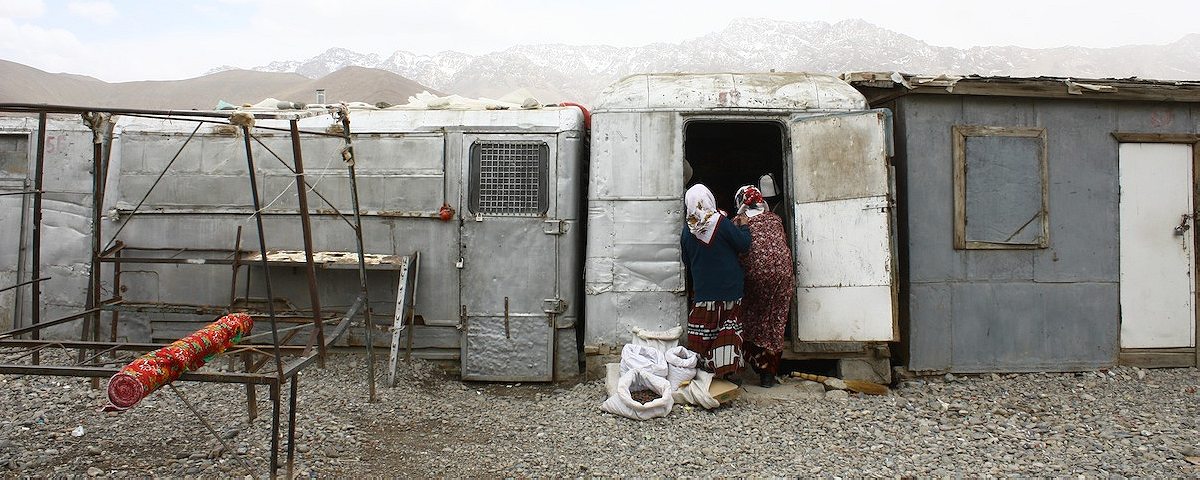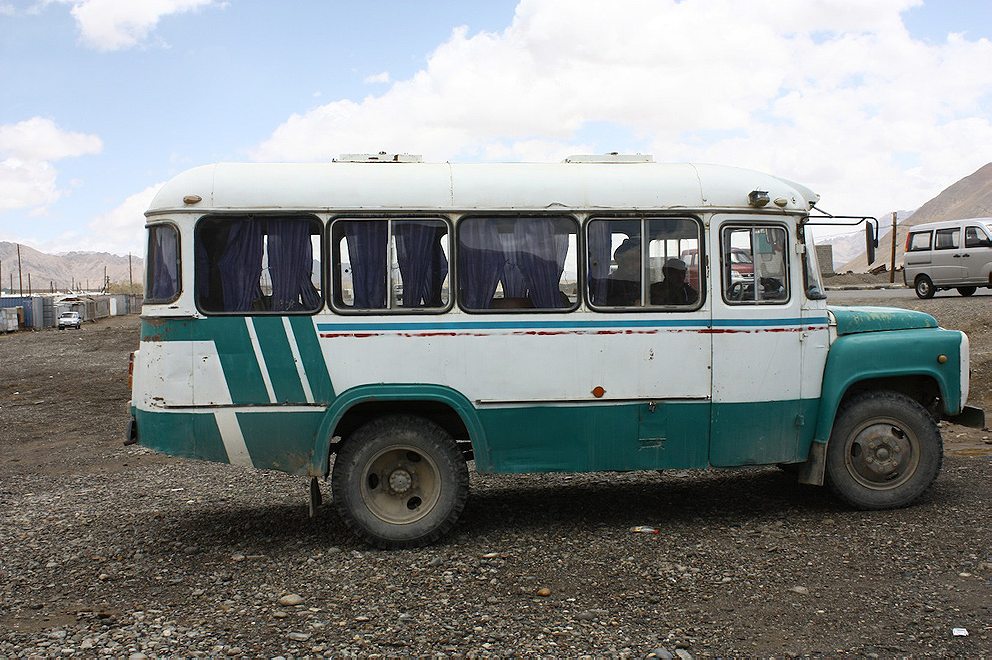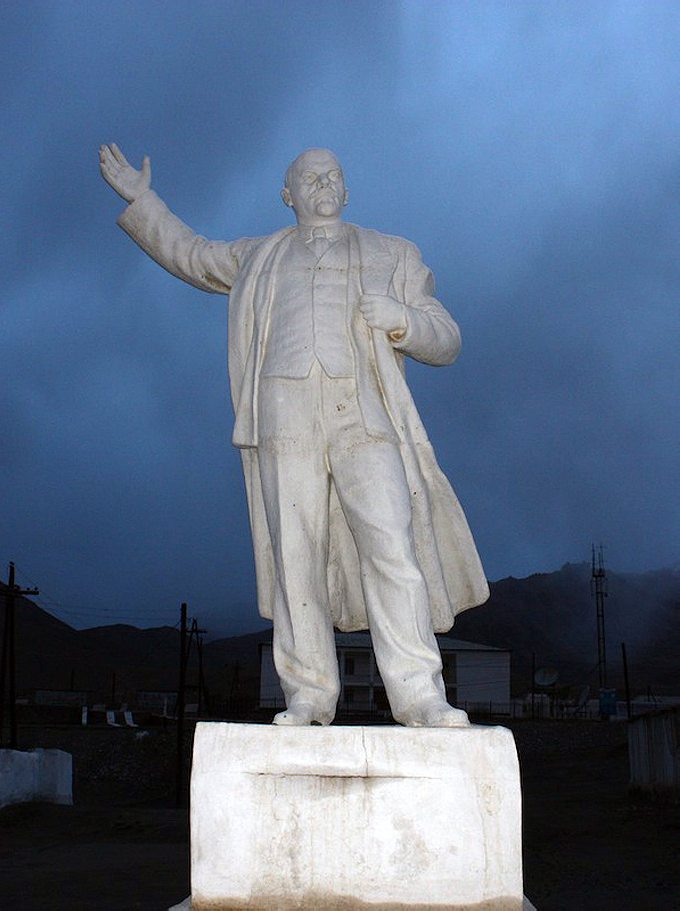Murghab in Tajikistan’s Pamir mountains: a desolate crossroads between the fading Soviet empire and the emerging power of China
“This is the worst place in the world.”
I was in Murghab, Tajikistan, and although I don’t like to make blanket judgments like that, I could see his point. The restaurant we were in was pleasant and cozy, but I had had to flee into it to escape the whipping wind, hail and bitter cold of the late May day. My walk around the town had presented an unrelentingly bleak landscape. Abandoned houses with collapsed whitewashed walls that exposed the mud brick underneath. Women with scarves wrapped around their entire head—only a small slit for the eyes—against the wind and dust. Trash everywhere, including a disconcerting amount of animal parts—feet, horns, clumps of fur.
I had come to Murghab because of where it sits on the map: on the borders of China and Afghanistan in the Pamir Mountains, the furthest reach of the Russian/Soviet empire. Between the geopolitical tectonic plates of Russia and China, Murghab feels like a fault line. And while it may be over a century old—it was actually founded by the Russians as a military outpost in 1895—Murghab still has a temporary, frontier feel. The shops in the bazaar are repurposed shipping containers. There is no regular electricity supply, so residents rely on gas generators or small solar panels.
Before the Russians came, this area was only lightly inhabited, by the few Kyrgyz nomadic yak- and sheep-herders tough enough to withstand its extreme climate. But as the Russian empire expanded to the east and south, this became a strategic location, near the borders with China and the British Empire (what is now Pakistan). The Soviets further reinforced their position here, hardening the borders and building the Pamir Highway, connecting Tajikistan’s capital of Dushanbe with Osh, in Kyrgyzstan. Murghab was a maintenance post for the road, and Soviets took pains to make sure that the town was well supplied and that its residents, for living in such a strategic, unpleasant, and unsalubrious place, were well subsidized.

But with the eclipse of the Soviet Union and Russia’s retreat from Central Asia, Murghab’s geopolitical status is again in flux. In 2011, Tajikistan announced that it had reached an agreement to hand over about 400 square miles of land to China. Tajikistan’s authoritarian government has released little information about the transfer, and few Tajiks ever make it to Murghab, about 24 hours of driving over miserable roads from Tajikistan’s capital, Dushanbe. So reliable information about the land transfer is scarce, and in the information vacuum rumors in the Russian and Tajik press have flourished: that China continues to take more land, that the Chinese military is occupying part of the Pamirs.
And so, curious about the current state of geopolitics in the Pamirs, I had come to Murghab. I had started in the pan-Third World bus station atmosphere of Khorog, the capital of Tajikistan’s Gorno Badakhshan Autonomous Province. With its soft-serve ice cream, fried dough-and-meat snacks, and imported bananas, it could be almost anywhere. Only the signs in Tajik—virtually identical to Farsi, but written in the Cyrillic script—and the women in their elegant shalwar kameez-like kurtas suggested we were in Tajikistan. Most of the cars in the lot were Tangems, the Chinese minivan that has in just a few years become ubiquitous in Central Asia. (There are a number of brands, but collectively they are commonly known as Tangem, after a Korean soap opera character who was popular when the vans appeared in Central Asia.) I’m not against the Tangem, but I wasn’t disappointed to get a seat instead in a far-more-comfortable Mitsubishi Pajero.


Out of Khorog, we climbed steadily up the Pamir Highway. Reaching the Koitezek pass (elevation above 14,000 feet) and the dividing line between the Western and Eastern Pamirs, the landscape quickly morphed. Leaving the craggy peaks and green valleys that had reminded me of Colorado, we entered an empty, reddish-brown landscape that more closely resembled Mars. Almost the only other vehicles on the road were Chinese trucks. The gold-toothed driver told me that the road has gotten substantially worse since Soviet times. Now, he said, too many heavy Chinese trucks drive it and maintenance is lax. Where the Khorog-Murghab journey used to take four or five hours, it now takes seven or eight. When we got to Murghab it was dark and a good thirty degrees colder than it had been in Khorog.
In the morning, I discussed the Chinese land grab with the hotel staff, and found out that the land in question is not far away, and happily near one of the Eastern Pamirs’s beauty spots, Lake Rang-Kul. The land is rich in resources—gold, silver, uranium, iron, coal, rubies, diamonds, salt, they told me. The details were unclear. They said no borders have been shifted but that the Tajikistan government has leased out the land to China for a quick somoni. “Everybody is unhappy about it,” they told me.
The border with China opened up in 2004, with a new border crossing at the Kulma Pass. But trade with China hasn’t really helped Murghab, I was told: Border trade is controlled by a company, Tojiron, believed to be run by a daughter of the Tajik president, and anyone who wants to ship anything to or from China has to go through them, he said. Tojiron doesn’t even have an office in Murghab, and trucks just pass through the town, ruining the roads. The reports of Chinese military occupation are false, I was told. There is one Russian officer at the military base here, “but we won’t accept anyone else, Chinese or Americans,” one told me.
Locals near the lake would be happy to show me exactly where the Chinese have encroached. But as I was making arrangements with a driver, we got word that the wind has whipped up a sandstorm at the lake so bad that people couldn’t go outside. So I instead settled for exploring Murghab some more.
There are no traces of old Pamirsky Post in Murghab, but it’s still recognizably Russian. With a mixed Tajik/Kyrgyz population, the lingua franca is Russian, and most signs in the town are in Russian. The shops are well stocked with vodka. And of course, there is a Lenin statue and a World War II monument. More generally, it’s impossible to separate out modern life in the Pamirs—literacy, cities (such as they are), women’s emancipation—from its history with Russia. At the regional history museum in Khorog, the first car, first airplane, first telephone in the Pamirs are all commemorated, all brought by Russians. The museum commemorates textile and pharmaceutical factories that the Soviets built in Badakhshan; the guide ruefully told me that they are now closed. The museum’s most famous exhibit is a piano brought from St. Petersburg in 1915. The final 200 miles there was no road at all, and it had to be carried by twenty porters.
Living in China and the USSR, their lives took very different trajectories
The only Chinese presence in Murghab is supposedly a truck stop on the outskirts of town. But when I got there it was empty, and only a sign with Tajikistan and Chinese flags suggesting anything international about it. Walking back into town, I passed a mosque whose imam was performing the call to prayer from the tiny minaret. Without electricity for amplification he had to rely on his voice. I didn’t see anyone coming. The wind picked up, and it started to hail.
I ducked into a cafe for lunch, and the proprietress, a voluble middle-aged Kyrgyz woman, opened up about how hard life is in Murghab. “Nothing grows here—no potatoes, no onions. Only meat and milk,” she said. People never live past 80 because of the hard conditions. And while the Soviets paid bonuses to families for having many children, those subsidies have disappeared, forcing people to drastically reduce the size of their families. “Families used to have 14 children! Now it’s three at the most.”
The nomadic Kyrgyz used to wander freely between what is now Tajikistan and China, and many families were split up when the borders were hardened after the establishment of the Soviet Union. Living in China and the USSR, their lives took very different trajectories. The proprietress has relatives whom she was only able to see after the border reopened. She went to visit them in Urumqi, and found that they didn’t even speak Kyrgyz any more, only Mandarin and Uyghur. (Kyrgyz and Uyghur are both Turkic languages, so they were able to manage with some effort.) I asked how her relatives there were different from those who had grown up in the Soviet Union. “They have more money there, a lot of money. But their lifestyle is so old-fashioned,” she said. They have refrigerators but instead prefer to preserve their food in salt. They don’t keep their money in safes but tied up in bundles on their body, and women of Muslim nationalities—Uyghur, Tajik, Kyrgyz—never wear pants.

But at the same time, her daughter, a modern young woman (at 30, still unmarried, her mother worries) has chosen to seek her fortune in China. She is finishing a master’s degree in Urumqi and then plans to move to Guangzhou. She is the exception—only three children from the town of Murghab are now in China, while many more are in Russia. But the mother worried about who will take care of Murghab’s parents when their children are abroad. And her belief that life in Murghab is superior to that in China—morally, if not materially, is unmistakable.
A friend of the proprietress’s, a young Kyrgyz man, overheard our conversation. “What are you talking about? Murghab is the worst place in the world!,” he said. “You should sell your house here and move with her to Guangzhou!” But she objected: “They would be talking, ya ya ya, and I wouldn’t understand anything. I would die of boredom!” The man joined a group of his friends, their conversation a long litany of complaints about the Chinese. They spoke in Russian, and drank vodka. I wondered how, 120 years ago in their yurts and over mare’s milk, their great-great-grandfathers had spoken about the Russians.
This reporting was made possible by a grant from the Pulitzer Center on Crisis Reporting.